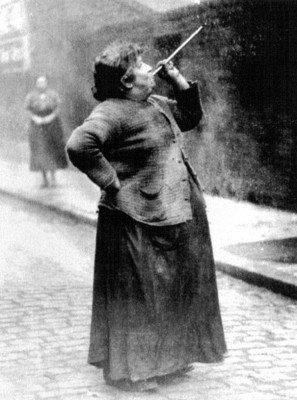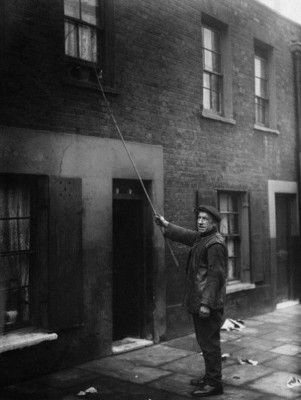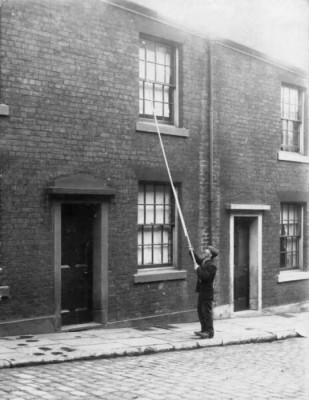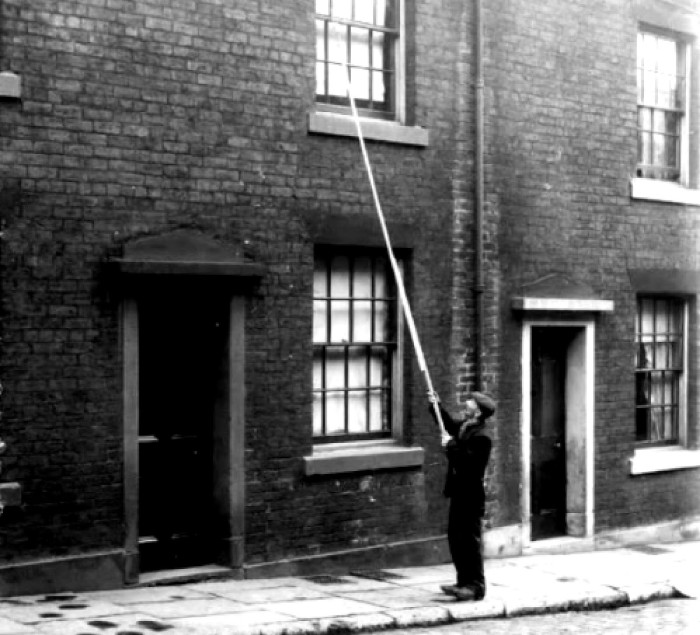Many old and honorable occupations that no longer exist have their origins deeply rooted in history when people worked many varying trades. Some of these professions are not what historians might consider to be mainstream work, but over the years, these various lines of work have provided interesting stories that can be passed down to future generations.
Even before the days of alarm clocks, people still needed to get to work on time. A knocker-up, sometimes known as a knocker-upper, was a profession in Britain and Ireland that started during and lasted well into the Industrial Revolution and at least as late as the 1920s.
A knocker-up is a person whose job was to go from house to house in the early morning and wake up workers by tapping on the bedroom window. They used a truncheon or short, heavy stick to knock on the clients’ doors or a long and light stick, often made of bamboo, to reach windows on higher floors. At least one of them used a pea-shooter. In return, the knocker-up would be paid. Most knocker-ups were paid weekly and these weekly fees were reasonable and usually based on how far the knocker-up had to travel and the time of day the person needed to be awakened. Generally, the job was carried out by elderly men and women, but sometimes police constables supplemented their pay by performing the task during early morning patrols.

A large number of people in this profession usually worked in larger industrial centers. The position gained prominence during the First Industrial Revolution when many people started to work in factories and needed to arrive at the same time. It was the knocker-ups duty to remain at their client’s household until they were awoken and out of bed. Larger Factories and Mills often employed their own knocker-ups to ensure workers made it to work on time.
The goal of a knocker-up was to get as many customers as possible and to cover as much ground as possible. For that reason, knocker-ups sometimes exchanged customers with one another. They developed a system to remember which houses needed to be knocked up and at what time. To keep customers straight, knocker-ups often chalked outside their customer’s homes with “all manner of figures, ‘1/2 past 3,’ 1/4 to 4,’ ‘5 o’clock,’ and such.” Besides displaying the time, the signboards also advertised a knocker-ups business and could be found hanging “over the doors of dingy cottages, or at the head of a flight of steps, leading to some dark cellar-dwelling, containing the words, ‘Knocking-Up Done Here.'”

However, some neighbors didn’t like the early morning noise, and there were reports of some knocker-ups being “pelted from windows” and having “water chucked down on [them].” This resulted in the adoption of “long taper[ed] wands, like fishing rods,” sometimes called a “snuffer outer“, which was also an implement used to extinguish gas lamps at dawn. Тhe advantage of these wands was that the knocker-up could tap, tap, tap and wake the paying customer rather than the non-paying neighbor.

Knocker-ups were popular enough for authors to include some sort of description of them. For instance, Charles Dickens talked briefly about a knocker-up in his book Sketches by Boz and Great Expectations and numerous weeklies and illustrated monthlies mentioned them at one time or another throughout the Industrial Revolution.
Want to become a trivia master? Sign up for our Today In History newsletter!
One question history has never answered: Who woke up the knocker-up? For some, it would appear that the technique in most cases was to stay up all night until they had finished their duties. Eventually, around the 1920s, reliable alarm clocks became affordable to the masses and the knocker-upper was no longer needed.
